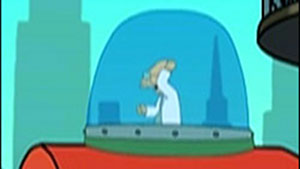
Neutron stars represent some of the densest objects known in the Universe. If they were any more dense, their immense mass would collapse in on itself, overwhelming all the other forces and forming a black hole. The exact nature of the material that makes up a neutron star is still hotly debated among theorists. A new study in this week's edition of Nature has put some hard limits on the nature of the super dense matter where, in the worlds of Professor Farnsworth "each pound of which weighs ten thousand pounds!"
Observations of the binary pulsar J1614-2230 were made using the National Radio Astronomy Observatory Green Bank Telescope and they followed the system through a complete 8.7 day orbital cycle. The astronomers took detailed measurements of the radio pulses that reached Earth. As these pulses, which originate from the rotation of the neutron star, passed by the companion white dwarf, their timing was delayed due to the highly warped nature of spacetime—an effect known as Shapiro delay. In a highly inclined, nearly edge-on system such as J1614-2230 the effect allows astronomers to make very accurate measurements both of the neutron star and its companion.
Using the delayed pulse measurements and fitting them to a detailed model of neutron stars, a team of Dutch and American astronomers calculated the mass of the neutron star in J1614-2230 as 1.97±0.01 solar masses. This makes J1614-2230 the heaviest neutron star measured to date, but it also greatly constrains the nature of the material that makes up a neutron star.
Theories abound on what makes up a neutron star, ranging from a simple collection of neutrons to much more exotic hadronic matter such as "hyperons or kaon condensates"—some have even suggested free quark condensates exist in these stars. This discovery immediately rules out some of the more exotic hadronic matter, since the theorized equations of state of such matter show that they cannot form stars this massive. Quark matter is not ruled out, but is tightly restricted and there wouldn't be any free quarks, but rather bound quark condensates.
While this may make the nature of neutron stars a bit more mundane, it gives theorists a whole new set of data that their theory must get right if it's to be considered a candidate for explaining the nature of the last stop before a black hole.
Nature, 2010. DOI: 10.1038/nature09466
reader comments
27